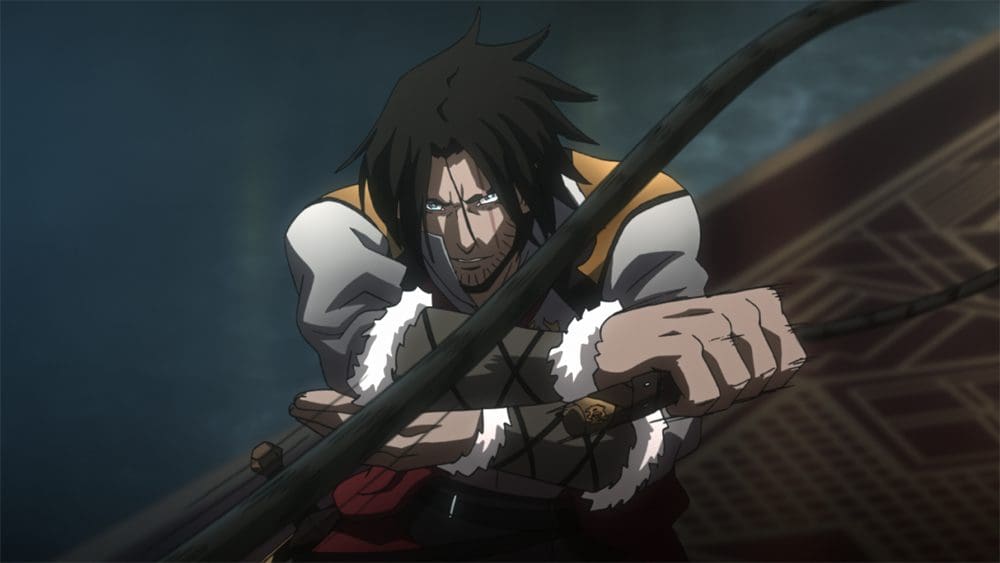
Castlevania Season 1 Plot Summary:
Dracula (Graham McTavish) unleashes a horde of monsters on Wallachia after a zealous Bishop (Matt Frewer) burns his beloved wife, Lisa (Emily Swallow), at the stake as a witch. Trevor Belmont (Richard Armitage), last scion of the monster-hunting Belmont family, must step up to protect the city of Gresit before Dracula’s army overruns it.
Video game adaptations have a fraught history, to say the least. Countless movies have been made attempting to capitalize on the success of some franchise or another, and they’ve almost all been unwatchable messes. Part of this could perhaps be attributed to the admittedly thin stories of their sources, but there are plenty of excellent movies and shows that manage to get by with fairly shallow plots. What is that missing X-factor that makes it so difficult to adapt a video game well? It’s hard to say, but whatever it is, Netflix’s new Castlevania adaptation definitely has it.
The series is a very loose adaptation of the NES game Castlevania III: Dracula’s Curse, which recounts the story of the first Belmont to fight Dracula, Trevor Belmont. Trevor is essentially a personality-less cipher in the game, so here he’s been reimagined as a jaded, drunken cynic. Initially reluctant to involve himself, even as Wallachia descends into chaos around him, he’s eventually dragged back into the monster-hunting business by the plight of a nomadic group of healers known as the Speakers and the prodding of one of their number, Sypha Belnades (Alejandra Reynoso). Finally stirred into action, Trevor joins Sypha and Dracula’s son Alucard (James Callis) on a quest to kill Dracula and end his assault once and for all.
At first glance, that synopsis could make it sound like Castlevania has all the same problems as other video game adaptations. After all, that’s still a pretty simplistic, well-worn story, and it’s not helped by dialogue that rarely rises above the level of stilted. And yet, it works. Part of this is because its economical story allows it to really focus in on the arc of Trevor Belmont. We first see him in much diminished state, barely able to win a bar fight against a bunch of drunken peasants. But then we see how his identification with the Speakers starts to reawaken his concern for others. And when the Speakers refuse to give up on the people of Gresit, they push him finally to start standing up to the monsters again, culminating in the full return of Trevor Belmont, vampire hunter, in his battle with Alucard. It’s a well-established character type, but the show commits to executing it, hitting all the right beats at all the right moments. It effectively grounds the story in Trevor’s journey and gives all the events a real sense of purpose.
Another part of what makes the show work so well is how it leans into the gothic horror implicit in the premise of Castlevania. The demonic menagerie that made up the enemies of the games are turned loose upon the people of Wallachia, and the result is gruesome. Eschewing any attempt to be kid-friendly, the show turns up the gore and lets its monsters engage in terrifying acts of carnage. This, and the grime of everyday life in a Renaissance world, is then contrasted with the sumptuous beauty of churches, castles, and cathedrals. The Bishop in particular, with his rich baritone, adds a real sense of gravitas to his scenes that enhances the spectacle around him. Even though the Bishop is little more than a one-dimensional sketch, he serves admirably as an antagonist for this season beyond the ever-present hordes. When these elements are combined, when the Bishop is confronted by a group of demons in his church, the result is one of the best scenes in the show.
All of this is tied together with some truly impressive animation. Whether it’s the technological splendor of Dracula’s castle, the rustic charm of a village tavern, or a gory battle with a monster, everything looks fantastic. For a show that is largely about action, this visual excellence is important, and the action scenes we get more than deliver. Something as simple as traversing the clockwork catacombs of Gresit becomes a treat thanks to the direction and art. And when it comes to something as complex as the climactic fight between Trevor and Alucard, the result is nothing less than astounding. Even with everything else it does right, no animated show can thrive without good animation, and thankfully Castlevania delivers.
In terms of simply being a show, nothing Castlevania does is particularly revolutionary. Its execution is superb, but the ideas that it’s executing are still fairly basic ideas that have been done well in the past. And yet, it accomplishes what so few others have done: make a good video game adaptation. Because it’s not just a good show. It successfully identifies which elements of the games are crucial to the identity of the series and utilizes them in a way that takes advantage of its new medium. That’s precisely what any good adaptation should seek to do, and it means any fan of Castlevania should end this show eager for the second season.

